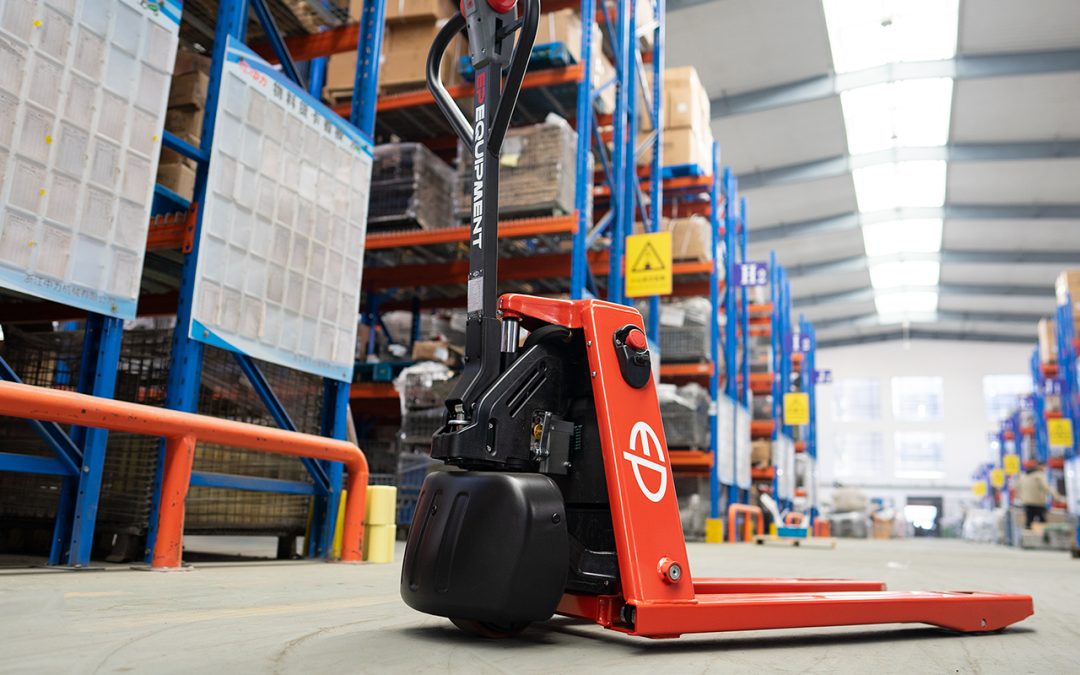Electric pallet trucks are designed for both lifting and moving loads across relatively short distances in different material handling applications like distribution centres, loading docks and warehouses. This comprehensive guide to pallet truck safety will discuss how to use these electric-powered pallet trucks safely helping operators to avoid property damage and personal injury while ensuring they deliver their loads successfully.
Pre-operational inspections
Before operating an electric pallet truck, the equipment and operating area must be inspected to ensure pallet truck safety. Walk around the truck, performing a visual check while ensuring that the work area is free of debris and safe to use the pallet truck on.
During this cursory inspection of the truck, check for any cracks or damaged parts and ensure there are no fluid leaks. Pay attention to the truck’s tyres, wheels, and forks to make sure they are in good working order. Additionally, make certain that any onboard safety devices required are attached securely and are in the correct condition. All data plates and warning labels should be visible.
Testing the operational controls
The next step is to make sure that the electric pallet truck is fully operational. Raise and lower the forks, then sound the onboard horn. You can then test the braking systems. Now check the reverse and forwards controls followed by the emergency reverse control. If any of these tests reveal an issue that will prevent the pallet truck from being used safely, it should be reported and decommissioned until repaired.
Pallet Truck Safety When Lifting
Always ensure that the load you select can be handled by the pallet truck’s capacity. If unsure, always ask your supervisor.
Before transporting a load there are two key points to understand. A load must be stable and positioned centrally on the pallet before it is moved. If it is not, it can topple during transit causing damage or injury. Loads that are unstable or off-centre must be repositioned and secured before transport.
Before lifting, make sure that both forks are entirely under the pallet and ensure that the load is positioned against the back. This can prevent pallet damage and loads from being spilt. Operators must pay attention and exercise caution both when setting forks and when lifting loads to avoid potential damage.
How to transport and place loads safely
Operators must make sure they know where they are going. They are advised to study their route first on foot to ensure the way is clear of any hazards or obstructions that can impede transportation or make it unsafe.
When in motion, operators should never adjust the pallet truck’s fork height. Loads should always be lifted off the ground before being moved and transferred to the drop point. When depositing a load, operators must ensure that the electric pallet truck has come to a complete stop first.
Walking with electric pallet trucks
For enhanced visibility which effectively lowers the possibility of accidental collisions, users should operate pallet trucks so that they are walking ahead of them and just off to the side. In circumstances where walking behind the truck is the only possible option, operators should exercise extra caution and keep both of their hands on the unit controls.
Regardless of orientation, operators should always use normal walking speeds when they are moving loads. Operators must stay attentive and observant of other people and vehicles working nearby. Always remember that the truck’s forks extend beyond the pallets they carry, so be mindful when approaching obstacles and objects in your path.
Pallet truck safety when parking
Operators must always lower their truck’s forks to ground level when parking. To stop unauthorised usage, when operators must leave a truck unattended and out of sight, the key should be removed and if necessary, the electric battery should be disconnected.
When parking, operators must ensure they do not block aisles, exits, work paths, or emergency equipment. Pallet trucks must never be parked on sloping surfaces.
Safe travelling on sloped surfaces
To stop the loads from tipping and falling, truck operators should always move straight up and down inclines and never take slopes at an angle. Operators must make sure that the pallet truck they are using, and its load are as stable as possible. Always keeping loads uphill when moving upwards and downwards on slopes can help accomplish this. When working on a slope, operators should never stand directly in front of a pallet truck but remain to the side.
Electric pallet trucks are a labour-saving alternative to standard types, but they do require expert training to operate them effectively and ensure pallet truck safety. To ensure they understand the best practices and latest advice on operation, all users should update their knowledge periodically.
By following these guidelines, electric pallet truck operators can ensure that no unnecessary damage is caused to either their equipment or the loads they carry. They can also mitigate the chance of personal injury, both to themselves and to others operating in the vicinity.
Get in touch with our team today to find out more.

